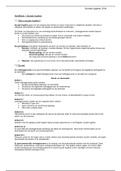Table of Content
Chapter 1: Sexuality in Perspective 2
Chapter 2: Theoretical Perspectives on Sexuality 7
Chapter 3: Sex Research 12
Chapter 4: Sexual Anatomy 15
Chapter 5: Sex Hormones, Sexual Differentiation, and the Menstrual Cycle 25
Chapter 6: Pregnancy and Childbirth 30
Chapter 7: Contraception and Abortion 36
Chapter 8: Sexual Arousal 42
Chapter 9: Sexuality and the Life Cycle: Childhood and Adolescence 50
Chapter 10: Sexuality and the Life Cycle: Adulthood 53
Chapter 11: Attraction, Love, and Communication 57
Chapter 12: Gender and Sexuality 62
Chapter 13: Sexual Orientation: Gay, Straight, or Bi? 67
Chapter 14: Variations in Sexual Behavior 71
Chapter 15: Sexual Coercion 75
Chapter 16: Sex for Sale 79
Chapter 17: Sexual Disorders and Sex Therapy 83
Chapter 18: Sexually Transmitted Infections 89
Chapter 19: Ethics, Religion, and Sexuality 93
Chapter 20: Sex and the Law 98
1 of 100
,Summary Sexology
Chapter 1: Sexuality in Perspective
Sex = Sexual anatomy and sexual behavior
Gender = Being male, female, or some other gender such as trans
• Note that almost all the research discussed in this book has assumed a gender binary—that is,
that gender has only two categories, male and female.
Sexual behavior = Behavior that produces arousal and increases the chance of orgasm
The History of Understanding Sexuality
Religion
• until about 100 years ago, religion provided most of the information about sexuality
• People of different religions hold different understandings of human sexuality (3 examples below)
• These religious views often have a profound impact
Ancient Greeks • acknowledged both heterosexuality and homosexuality
• explained this existence in a myth in which the original humans were double creatures
split into two halves
Fifteenth century • Belief that ‘wet dreams’ (nocturnal emissions) result from intercourse with tiny spiritual
Christians creatures called incubi and succubi
• The person who had wet dreams was considered guilty of sodomy as well as witchcraft
Muslims • sexual intercourse as one of the finest pleasures in life
• reflecting the teachings of the great prophet Muhammad
Science
• the scientific study of sex began in the 19th century (with the background of religious
understanding)
• interdisciplinary (biologists, psychologists, sociologists, …)
Important sex researchers
Anton van • Dutch microscopist
Leeuwenhoek • discovered sperm swimming in human semen
Oskar Hertwig • first observed the actual fertilization of the egg by the sperm in sea urchins (1875)
• ! the ovum in humans was not directly observed until the 20th century!
Sigmund Freud • Physician in the Victorian time
• Founder of Psychiatry and Psychoanalysis
• Sexuality is considered both the primary force in the motivation of all human behavior
and the principle cause of all forms of neurosis
Henry Havelock Ellis • Physician
• Studies in the Psychology of Sex (1896)
• Forerunner of modern sex research
• Women, like men, are sexual creatures
• Masturbation is common
• Physical and psychological factors play a role in sexual problems
• Sexual deviations from the norm are often harmless (accept them!)
Richard von Krafft- • Psychiatrist
Ebing • Psychopathia Sexualis: eine Klinisch-Forensische Studie
• Described sexual disorders based on patients’ experiences
• He coined the terms sadism, masochism, pedophilia, homosexuality, heterosexuality
2 of 100
,Summary Sexology
Magnus Hirschfeld • Founder of the first sex institute
• Administered the first large-scale sex survey obtaining data from 10,000 people on a
130-item questionnaire
• Unfortunately, almost everything is destroyed by the Nazis
• Introduced the term ‚transvestite’
Alfred Kinsey • Zoologist, Entomologist, Sexologist
• Founding father of the Institute of Sex Research (1947)
• Sexual Behavior in the Human Male (1948) and Sexual Behavior in the Human Female
(1953), also known as the Kinsey Reports
• Kinsey Scale measures sexual orientation on a 7-point scale
Masters and • Conducted most famous observational sex research
Johnson • Studied the physiology of sexual response and sexual disorders
• Human Sexual Response (1966) and Human Sexual Inadequacy (1970)
The Media
• may today play the same role that religion did in previous centuries
• References to safer sex are rare (only 2% portray any sexual precautions)
• Selectivity = In media theories, the principle that people select and pay attention only to certain
media and ignore others (important process). People select media content according to their own
needs, and seek information that is consistent with their own views.
• Greater online safety for youth today than in the past (e.g. more talks about online safety)
Several types of possible media influence on us
Cultivation theory • (In communications theory)
• The view that exposure to the mass media makes people think that what they see
there represents the mainstream of what really occurs
Framing theory • Media draw attention to certain topics and not to others, suggesting how we
should think about or frame the issues
• The media tell us what is important and what is not
Social cognitive theory • (In communications theory)
• The idea that the media provide role models whom we imitate
• media influences our behavior, thoughts, and affect (emotions) through processes
such as modeling, imitation, and identification
Reinforcing spiral theory One’s social identities and ideologies predict one’s media use and, in turn, media
use affects our identity and beliefs
Differential susceptibility • Some people are more susceptible than others to certain types of media
model • e.g. violent media
Cross-Cultural Perspectives on Sexuality
• Humans are unique in the way that cultural learning accumulates over time
• Culture = Traditional ideas and values passed down from generation to generation within a group
and transmitted to members of the group by symbols (such as language)
• Individualistic vs. collectivistic cultures
• Honor cultures = Those that stress „face“, that is individual’s reputation and the respect or honor
that people show toward others. E.g. in the Middle East, in the souther part of the US
• e.g. it might seem reasonable to stone to death a woman who committed adultery
3 of 100
,Summary Sexology
• Ethnocentrism = The tendency to regard one’s own ethnic group and culture as superior to
others and to believe that its customs and way of life are the standards by which other cultures
should be judged
• Incest taboo = A societal regulation prohibiting sexual interaction between blood relatives that is
nearly universal
• Regulations vary greatly from one society to the next and sexual behavior and attitudes vary
correspondingly
Variations in sexual techniques
• Kissing is one of the most common sexual techniques in our culture but there are few societies in
which kissing is unknown
• Variations in technique of kissing
• Inflicting pain as part of sexual technique in some cities
• The frequency of intercourse for married couples varies considerably from one culture to the next
• Most groups have restrictions that forbid intercourse at certain times/situations (e.g. postpartum
sex taboo)
Masturbation
• varies widely across culture
• some cultures tolerate or even encourage it during childhood and adolescence
• other cultures condemn or even severely punish it
Premarital and extramarital sex
• Most of Pacific Island societies, African and Eurasian societies permit premarital sex whereas
most of the Mediterranean societies prohibit premarital sex
• Extramarital sex is complex and conflicted for most cultures
• Even when extramarital sex is permitted it is subjected to regulations
• e.g. allowed for husbands but not wives
Sex with same-gender partners (aka homosexuality)
• strong disapproval at any age vs. encouragement
• even across European nations, attitudes vary considerably (NL very positive; LT very negative)
• Two rules:
I. Homosexuality is universal (no matter how treated in a particular society)
II. Homosexuality is never the predominant form of sexual behavior for adults in any society
• Sexual identity as an unvarying, lifelong characteristic of the self is unknown or rare in some
cultures (e.g. Indonesia) and an unquestioned assumption in other nations (e.g. US)
Standards of attractiveness
• important in determining a sex partner
• what is considered attractive varies considerably (eyes vs. ears vs. genitals)
• our society’s standards are in the minority in one way: most cultures consider a plump woman as
more attractive than a thin one
• one general rule: A poor complexion is considered unattractive in the majority of societies
Sexuality in two societies
• Ines Beag (island near Ireland):
• one of the most naive and sexually repressive societies in the world
• no knowledge of several sexual activities
• menstruation as a source of fear
• Managua (island in the South Pacific):
• sex for pleasure and for procreation
4 of 100
, Summary Sexology
• boys get taught different kind of sexual techniques
• having several partners is encouraged
Social-Class and Ethnic-Group Variations in the United States
→ large variations in sexual behavior within our culture (i.e. NO uniform standard)
Social class and sex
• education as an indicator of social class
• variations in sexuality: e.g. the use of the pill rises with the level of education
• AND: probably social class and sexuality mutually influence each other
• higher percentage for college students to marry after premarital cohabitation
• also some social-class similarities: e.g. the percentage of first marriage for men that still intact
after 20 years
Ethnicity and sexuality in the US
• variations as a result of different culture heritages; current economic and social conditions
• Two important points:
I. There are ethnic-group variations AND ethnic-group similarities
II. Cultural context is the key
• African Americans
• some factors that influence sexuality are the same as for Euro-Americans, such as:
• → legacies of the Victorian era; Judeo-Christian traditions
• 3 aspects that make sexuality different:
1. the African heritage
2. the forces that acted upon Blacks during slavery
3. current economic and social conditions
• heterogeneity across African Americans (e.g. rural, southern, urban, Caribbean) → reflected in
sexual attitudes
• lower marriage rate (unequal gender ratio; obstacles to seek/maintain a job)
• striking difference: Blacks are considerably less likely to engage in oral sex before the first time
they engage in vaginal intercourse (BUT: about as likely as White to engage in oral sex)
• Latinos
• = People of Latin American heritage
• Latinx = A term for Latinos that gets around the gender designations of Latino/Latina and
includes people outside the gender binary
• Gender roles are sharply defined (e.g. greater freedom for boys vs. obedience in girls)
• machismo = „maleness“; man is responsible for the well-being and honor of his family
• marianismo = motherhood is highly valued; virginity until marriage closely guarded
• familismo = a strong cultural valuing of one’s nuclear and extended family
• Asian Americans
• traditional Asian cultures have been repressive about sexuality/ sexual conservatives
• Several core values:
1. Collectivism → other’s needs should be considered before one’s own
2. Conformity to norms: → shame as an powerful force shaping good behavior
3. Emotional control → emotions should not be openly expressed (e.g. love; passion)
• American Indians
• Portrayal in the media:
• Men → noble savages; exotic and erotic; nearly naked; standards of masculinity
• Women → less visible; stereotyped as princess (beautiful; erotic) or squaws (unattractive)
• strict courtship rules regulating premarital sex
• today: great pressure in the youth culture to have sex
5 of 100










